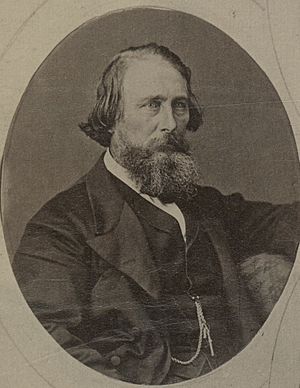Henry Kent Hughes facts for kids
Henry Kent Hughes (born around 1814 – died August 30, 1880) was an important person in early South Australia. He was a pastoralist (someone who owns and manages large farms for sheep or cattle) and a politician. He served in the South Australian House of Assembly from 1868 to 1875. He represented areas like Victoria and Port Adelaide.
Contents
Henry Kent Hughes's Early Life
Henry Kent Hughes was born in England around 1814. He married Jane Hilditch. In 1851, they traveled to South Australia on a ship called the Raleigh. They arrived at Port Adelaide on January 15, 1851.
Pioneering in Victoria
Before coming to South Australia, Henry spent time in the colony of Victoria. This was from about 1838 to 1844. He was part of a group that helped settle the Goulburn Valley area in Victoria.
With his two brothers, he started a property that later became the town of Avenel. The name "Avenel" might have come from a village in England, or perhaps from a fictional castle in a book by Sir Walter Scott.
Building Businesses
Around 1854, Henry Kent Hughes started a business with John Hart. John Hart later became a leader (premier) of South Australia. Their company was called Hart & Hughes.
They built the very first flour mill in Port Adelaide. This mill helped turn grain into flour. Henry was a quiet partner in this business. Later, in 1882, this company joined with other businesses to form the Adelaide Milling Co..
Henry also bought large properties along the Murray River. He raised sheep there with his brother, Edmund Chauntrell Hughes. They were very successful because they took good care of their sheep and prevented diseases.
Other Interests and Contributions
Henry Kent Hughes was involved in more than just business and politics. He was a director of the National Bank.
His most important public work was helping the Church of England's Orphans' Home for Girls. He served as the Secretary and Treasurer for the home. His wife, Jane, was also one of the people who helped start this home.
Henry's home in Adelaide was called "Avenel." It was a large house with ten rooms in North Adelaide. The land around his home, called "Avenel Gardens," was later divided into smaller blocks in the 1890s.


